语言学教程第三章重点
语言学课件—第三章 词汇
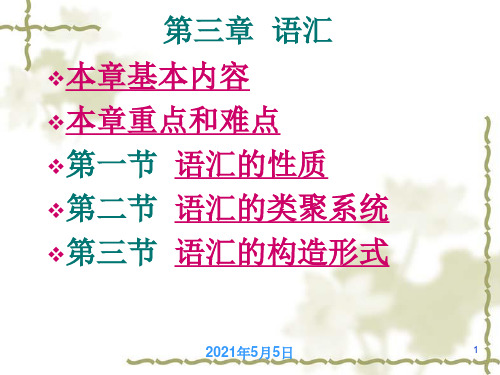
2021年5月5日
7
第二节 语汇的类聚系统
❖ 一、语汇系统的不同类聚关系 ❖ 二、词的分类 ❖ 三、语的分类
2021年5月5日
8
一、语汇系统的不同类聚关系
❖ 1、组合关系和聚合关系
❖ 2、语汇的不同类聚系统
组合关系:符号和符号组合起来的关系。 聚合关系:在语言符号组合链条中的某一环节上能够互相替 换的符号具有某种相同的作用,并自然聚集成群,其间的关 系语就言是符聚号合系关统系具。有组合和类聚的特点。语汇系统内部也具有组 合和类类聚聚关的系特是点在,组它合表关现系为中具体有现相出同来特的点,的组语合或关者系词又聚体积现成为类聚, 形合成类一的个线类性聚序系列统。。语汇的类聚系统首先分成“词”和“语”两 大类。 词:既是语汇单位又是语法单位。词是最小的、音义结合的、 能独立使用的语言单位。 语:只是语汇单位,指由两个以上的词构成的意义较凝固、常 作为一个整体单位使用的固定词组或熟语性语言片断。
人类为登明月日计黄划花的、实半现斤,八英两语不中可出改现为d半ee斤ps五p两ac等e (等外。层空间),随着民权运动而产生
sit-in (静坐抗议),信息时代产生“英特网”、“伊妹儿”等。b语汇的变化不
是随心所欲的,它受到语汇系统和社会规约的双重制约,也有极强的稳定性。
2021年5月5日
6
三、语汇和语汇学
2021年5月5日
9
二、词的分类
音节数量 单音节词-双音节词-多音节词
语素数量
单纯词、合成词
构造 语音
音形关系
同音同形-同音异形-异音同形
词 地位 的 用途
地位
基本词汇、一般词汇
分
用途特点
常用词汇、非常用词汇
语言学教程胡壮麟(第四版) 第3章

Chapter 3 From Morpheme to Phrase第一部分The formation of word——Morpheme词的构成1. Morpheme 词素的定义Morpheme is the smallest meaningful unit of language in regard to the relationship between sounding and meaning, a unit that cannot be divided into further smaller units without destroying or drastically altering the meaning, such as boy and –s in boys, check and –ing in checking. And the systematic study of morpheme is a branch of linguistics called morphology2. Types of morphemes 词素的种类①Free morpheme and bound morpheme 自由词素和黏着词素Free morphemes: Those that may occur alone, that is, those which may make up words by themselves, are free morphemes, such as Dog, nation.Bound morphemes: Those that cannot occur alone. They must appear with at least one different morpheme, are called bound morphemes, for example, the word distempered has three morphemes, namely, dis-, temper, and –ed, of which temper is a free morpheme, dis- and –ed are two bound morphemes.②Root, affix and stem 词根、词缀和词干A root is the base form of a word that cannot be further analyzed without destroying its meaning. That is to say, it is that part of the word that remains when all the affixes are removed. For example, in the word internationalism, after the removal of inter-, -al and -ism, what is left is the root nation. Therefore, all words contain a root morpheme.A root may be free or bound. First, free root morphemes are those that can stand by themselves and are the base forms of words, such as black in black, blackbird, blackboard, blacksmith. A language may contain many morphemes of this type. Second, there are relatively a few bound root morphemes in English, such as -ceive in receive, perceive and conceive: -mit in remit, permit, commit and submit: -tain in retain, contain and maintain, among many othersA few English roots may have both free and bound variants. E.g. the word sleep is a free root morpheme, whereas slep- in the past tense form slept cannot exist by itself, and therefore bound.An affix is the collective term for the type of morpheme that can be used only when added to another morpheme. They are classified into three subtypes, namely, prefix, infix, and suffix. Prefix such as para-, mini- in paragraph and miniskirt; Infix such as –ize, -tion in colonize and revolution; Suffix such as –ee- in feet (vs. foot).A stem is any morpheme or combination of morphemes to which an inflectional affix can be added, so both friend- in friends and friendship- in friendships are stems. The former shows that a stem may be the same as a root, whereas the latter shows that a stem may contain a root and one, or more than one, derivational affix.③Inflectional affix and derivational affix 屈折词缀和派生词缀Inflection is the manifestation of grammatical relationships through the addition of inflectional affixes, such as number, person, finiteness, aspect, and case, which don’t change the grammatical class of the stems to which they are attached.The distinction between inflectional affixes and derivational affixes is sometimes known as a distinction between inflectional morphemes and derivational morphemes. We can tell the difference between them with the following ways:1)First, inflectional affixes are generally less productive than derivational affixes. They often add a minute or delicate grammatical function to the stem, such as toys, walks, John’s. Therefore, they serve to produce different forms of a single lexical item. However, derivational affixes are very productive in making new words. For example, cite, citation, cital. So derivational affixes often change the lexical meaning.2)Second, inflectional affixes don’t change the word class of the word they attach to, such as flower, flowers, whereas derivational affixes might or might not, such as the relation between small and smallness for the former, and that between brother and brotherhood for the latter.3)Third, that whether one should add inflectional affixes or not depends very often on other factors within the phrase or sentence at stake. For example, the choice of likes in “The boy likes to navigate on the Internet.” is determined by the subject the boy in the sentence. However, derivational affixes are more often based onsimple meaning distinctions. For example, the choice of clever and cleverness depends on whether we want to talk about the property “clever” or we want to talk about “the state of being clever”.4)Fourth, in English, most inflectional affixes are suffixes, which are always word final. E.g. drums, walks, Mary’s. But derivational affixes can be either prefixes, suffixes, or both at the same time. E.g. depart, teacher, international.3. Allomorph and morphological change 变体①allomorph 词素变体An allomorph is the alternate shapes of the same morpheme. Words such as illogical, imbalance, irregular and inactive share a common morpheme in-. In other words, il-, im-, and ir- are exceptionally the variation forms of one morpheme in-. These variation forms are called Allomorphs, i.e. allomorphs of the same morpheme owing to the influence of the sounds to which it attaches.②morphological change 形态变化Morphological change takes the form of inflectional changes in affixes.第二部分Word 词1. word 词和词项的定义Word is a typical grammatical unit between Morpheme and Word Group, such as boy, check, write, and fat. Lexical items refer to the cases when a word appears in different forms, such as boy and boys, or check, checks, checked, and checking. So Word is a general, covering term (boy and boys are one word) and Lexical Item a specific term (boy and boys are two lexical items).2. Three characteristics of word 词的三个特性①Stability 稳定性Words, concerning their internal structures, are the most stable of all linguistic units, Generally speaking, it is hard for one to re-arrange the internal structure of a complex word into a different order. For example, the word chairman cannot be re-arranged as * manchair, the latter being an unacceptable word in English.②Relative uninterruptibility 相对连续性Uninterruptibility means that new elements should not be inserted into a word, even when there are several parts in it. For example, nothing should be inserted in between the three parts of the word disappointment: dis + appoint + ment.③ A minimum free form 最小的自由形式Leonard Bloomfield advocated treating sentence as “the maximum free form” while word as “the minimum free form”. Word is the smallest unit that can be used, by itself, as a complete utterance. For example, Is Jane coming tomorrow? Possibly.3. Classification of words 词的种类①Variable and invariable words 可变词与不变词V ariable words have inflective changes. That is, the same word may have different grammatical forms but part of the word remains relatively constant. E.g. follow – follows – following – followed.Invariable words refer to those such as since, when, seldom, hello. They don’t have inflective endings.②Grammatical words and lexical words 语法词(功能词)和词汇词(实义词)Grammatical words(function words):Those that mainly work for constructing group, phrase, clause, clause complex, or even text are grammatical words, such as conjunctions, prepositions, articles and pronouns. Lexical words(content words):Those that mainly work for referring to substance, action and quality, such as nouns, verbs, adjectives and adverbs, are lexical words.③Closed-class words and open-class words 封闭类词和开放类词Closed-class word: A word that belongs to the Closed-class is one whose membership is fixed or limited, such as pronouns, prepositions, conjunctions, articles, and others.Open-class word: the Open-class is one whose membership is in principle infinite or unlimited. When new ideas, inventions or discoveries emerge, new members are continually and constantly added to the lexical system of a language.④Word class(part of speech)词类This is close to the notion of parts of speech in traditional grammar.Nine word classes were established: they were noun, verb, adjective, adverb, conjunction, preposition, article, pronoun, and interjection.Today, a few more word classes have been introduced into grammer.i. Particles助词Particles include at least the infinitive marker “to” , the negative marker “not”, and the subordinate units in phrasal verbs, such as “get by”, “do up”, “look back”.ii. Auxiliaries助动词Auxiliaries used to be regarded as verbs. Because of their unique properties, which one could hardly expect of a verb, linguists today tend to define them as a separate word class.iii. Pro-form代词形式The items in a sentence which substitute for other items or constructions are called Pro-forms. For example, in the following conversation, so replaces that I can come.A: I hope you can come.B: I hope so.iv. Determiners限定词Determiners refer to those words that are used before the noun acting as head of a noun group, and that determine the kind of reference the nominal group has.第三部分Word formation 词汇构成1. Word formation(1):From Morpheme to Word 从词素到词(1) The inflectional way of formationInflection indicates grammatical relations by adding inflectional affixes, such as number, person, finiteness, aspect and case, which don’t change the grammatical class of the stems to which they are attached. For example, Table/tables.(2) The derivational way of formationDerivation, in its restricted sense, refers to the process of how new words are formed. It can be further divided into two sub-types: the derivational type (derivation) and the compositional type (compound).①Derivation派生Derivation shows a relationship between roots and affixes. In contrast to inflections, derivations can make the word class of the original word either changed or unchanged.E.g. Changed: delight+ful=delightful; unchanged: non+smoker= nonsmoker②Compound合成Compounds refer to those words that consist of more than one lexical morpheme, or the way to join two separate words to produce a single form, such as sunrise, cloakroom, railway. It can be divided into two types:(1) Invention 发明法Technological and economic activities are the most important and dynamic in modern human life, many new lexical items come directly from them, such as Coke, nylon.(2) Blending 混成法Blending is a relatively complex form of compounding, in which two words are blended by joining together the initial part of the first word and the final part of the second word, or by only joining the initial parts of the two words. For example, smoke+ fog →smog; breakfast + lunch →brunch.(3) Abbreviation / Clipping 缩写法/截断法A new word is created by cutting the initial part or the final part or cutting both the initial and the final parts of the original words. E. g. telephone→phone; fanatic→fan; influenza→flu.(4) Acronym 首字母缩略词Acronym is made up from the first letters of the name of an organization, which has a heavily modified headword. E. g. WTO→World Trade Organization(5) Back-formation 逆构词法Back-formation refers to an abnormal type of word-formation where a shorter word is derived by deleting an imagined affix from a longer form already in the language. E. g. editor→edit(6) Analogical creation 类推构词法The principle of analogical creation can account for the co-existence of two forms, regular and irregular, in the combination of some English verbs. E. g. work →wrought →worked.(7) Class shift 词性变换By shifting word class one can change the meaning of a word from a concrete entity or notion to a process or attribution. This process of word formation is also known as zero-derivation, or conversion. E. g. Engineer(v/n)(8) Borrowing 借用English in its development has managed to widen its vocabulary by borrowing words from other languages, such as Greek, French, Spanish and other languages have all played an active role in this process. There are four types of borrowing:①Loanwords(全部借词):a process in which both form and meaning are borrowed with only a slight change.E. g. coup d’ état , tea , 秀,脱口秀②Loanblend(混合借词):a process in which part of the form is native and the rest has been borrowed, but the meaning is fully borrowed. E. g. Chinatown 吉普车③Loanshift(转移借词):a process in which the meaning is borrowed, but the form is native. E. g. artificial satellite from the Russian S putnik.④Loan translation(翻译借词):a special type of borrowing, in which each morpheme or word is translated in the equivalent morpheme or word in another language, also called Calque. E. g. black humor (humour noir), found object (objet trouve).第四部分Word group and phrase 词组和短语Word group is a group of words, it is an expansion of a word.Phrase is a contraction of a clause nominal group, such as Verbal group, Adverbial group, preposition group.。
语言学教程Chapter3
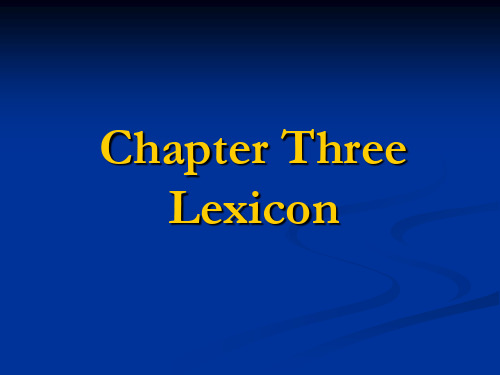
Affix: the type of formative that can be used only when added to another morpheme. Normally divided into prefix (dis-, un-) and suffix (-en, -ify).
Root: the base form of a word that cannot be further analyzed without total loss of identity, eg friend as in unfriendliness. Roots may be free: those that can stand by themselves, eg black+board; nation+-al; or bound: those that cannot stand by themselves, eg -ceive in receive, perceive, conceive.
write, writes, writing, wrote, written
A grammatical unit: sentence clause phrase word morpheme Problem: blackboard
1.2 Identification of words
Stability: stable linguistic units. chairman, but not *manchair Relative uninterruptibility: though we recognize three components in the word disappointment, we cannot pause and add another component in between, as in *disinterestappointment. But we can add another word between words: Paul, (John) and Mary ...
胡壮麟《语言学教程》笔记1_3章
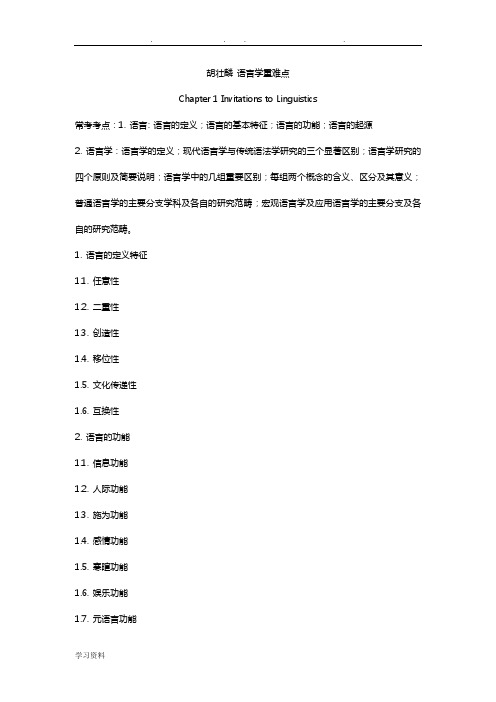
胡壮麟语言学重难点Chapter 1 Invitations to Linguistics常考考点:1. 语言: 语言的定义;语言的基本特征;语言的功能;语言的起源2. 语言学:语言学的定义;现代语言学与传统语法学研究的三个显著区别;语言学研究的四个原则及简要说明;语言学中的几组重要区别;每组两个概念的含义、区分及其意义;普通语言学的主要分支学科及各自的研究范畴;宏观语言学及应用语言学的主要分支及各自的研究范畴。
1. 语言的定义特征1.1. 任意性1.2. 二重性1.3. 创造性1.4. 移位性1.5. 文化传递性1.6. 互换性2. 语言的功能1.1. 信息功能1.2. 人际功能1.3. 施为功能1.4. 感情功能1.5. 寒暄功能1.6. 娱乐功能1.7. 元语言功能3. 微观语言学3.1. 语音学3.2. 音系学3.3. 形态学3.4. 句法学3.5. 语义学3.6. 语用学4. 宏观语言学4.1. 心理语言学4.2. 社会语言学4.3. 应用语言学4.4. 计算语言学4.5. 神经语言学5. 重要概念及其区分5.1. 描写式&规定式5.2. 共时&历时5.3. 语言&言语5.4. 语言能力&语言应用5.5. 唯素的&唯位的5.6. 传统语法&现代语法5.7. 语言潜势&实际语言行为Chapter 2 Speech Sounds常考考点:1. 语音学语音学的定义;发音器官的英文名称;英语辅音的定义;发音部位、发音方法和分类;英语元音的定义和分类;基本元音;发音语音学;听觉语音学;声学语音学;语音标记,国际音标;严式与宽式标音法2. 音系学音系学的定义;音系学与语音学的联系与区别;音素、音位、音位变体、最小对立体、自由变体的定义;音位理论;自由变异;音位的对立分布于互补分布;语音的相似性;区别性特征;超语段音位学;音节;重音;音高和语调。
语言学教程[第三章词汇]山东大学期末考试知识点复习.
![语言学教程[第三章词汇]山东大学期末考试知识点复习.](https://img.taocdn.com/s3/m/e5f0454acfc789eb162dc854.png)
第三章词汇复习笔记I.词词是个语言表达单位,无论是在口语还是在书面语中,说母语的人都能够凭直觉识别这个语言单位。
1.词的三种含义(1词是自然的有界限的对立单位;(2词既是一个普通术语又是一个专门术语;(3词是一个语法单位。
2.词的识别(1稳定性就词的内部结构而言,词是所有语言单位中最稳定的。
(2相对连续性连续性指的是一个词的几个成分之间不可介入新的成分,即使这个词由多个成分构成。
(3最小的自由形式词是能够独立构成一个完整语句的最小单位。
3.词的分类(1可变词和不变词可变词有形态变化,即词的一部分保持不变,另一部分有规则地变化以实现不同的语法功能。
小变词没有形态变化。
具有词汇意义 (指代物质、动作和性质的词称为词汇词,例如名词、动词、形容词和副词。
表达语法意义的词是语法词,例如连词、介词和代词。
(3封闭类词和开放类词封闭类词的成员数目固定,数量有限。
像代词、介词、连词和冠词都属于封闭类词,一般不能轻易增加或衍生新的成员。
相比之下,开放类词的成员数目基本上是无限的,其数目会随着社会发展不断地、经常地增加。
名同、动词、形容词和副词属于开放类词。
(4词类在传统的名词、代词、形容词、动词、副词、介词、连词、感叹词和冠词的基础上,可新增助词、助动词、代词形式、限定词。
Ⅱ.语素和形态学1.定义语素是最小的语言单位,不能再进一步分成更小的单位而不破坏或彻底改变词汇意义或语法意义。
形态学研究词的内部结构以及词的构造规则,包括屈折变化和词的形成两个领域。
2.语素的类型(1自由语素和粘着语素①自由语素指能够单独出现或独立成词的语素。
所有的单语素词都是自由语素,由自由语素构成的多语素词为复合词。
②粘着语素指不能单独出现,必须跟至少一个其他语素共同出现的语素。
①词根是构成词的基础成分,不能再做进一步分析而不破坏其意义。
每个词都包括一个词根语素.它可以是自由语素或粘着语素。
②词缀是那些只能附着于另一个语素 (词根或词干上的一类语素的总称。
胡壮麟版《语言学教程》 第三章Chapter3 Lexicon 总结

(2) Relative uninterruptibility 相对连续性
By uninterru ptibility, we men new elements are not to be inserted into a word even when there are several parts in a word. Nothing is to be inserted in between the three parts of the word disappointment: dis + appoint + ment. Nor is one allowed to use pauses between the parts of a word: * dis appoint ment.
Lexicon Change 词的变化
Phonological Change 音位 Orthographic Change 拼写变化
3.1 What is word?
WORD is a unit of expression that
native spears may recognize by intuition, whether it is expressed in spoken or written form. A WORD is the smallest of the linguistic units that can constitute, by itself, a complete utterance in speech or writing.
(2)Word both as a general term and as a specific term 作为一般用语和具体用语的词 作为一般用语和具体用语的词(The common factor underlying a set of forms)
胡壮麟语言学教程笔记重点

《语言学教程》重难点学习提示第一章语言的性质语言的定义:语言的基本特征(任意性、二重性、多产性、移位、文化传递和互换性);语言的功能(寒暄、指令、提供信息、询问、表达主观感情、唤起对方的感情和言语行为);语言的起源(神授说,人造说,进化说)等。
第二章语言学语言学定义;研究语言的四大原则(穷尽、一致、简洁、客观);语言学的基本概念(口语与书面语、共时与历时、语言与言学、语言能力与言行运用、语言潜势与语言行为);普通语言学的分支(语音、音位、语法、句法、语义);;语言学的应用(语言学与语言教学、语言与社会、语言与文字、语言与心理学、人类语言学、神经语言学、数理语言学、计算语言学)等。
第三章语音学发音器官的英文名称;英语辅音的发音部位和发音方法;语音学的定义;发音语音学;听觉语音学;声学语音学;元音及辅音的分类;严式与宽式标音等。
第四章音位学音位理论;最小对立体;自由变异;互补分布;语音的相似性;区别性特征;超语段音位学;音节;重音(词重音、句子重音、音高和语调)等。
第五章词法学词法的定义;曲折词与派生词;构词法(合成与派生);词素的定义;词素变体;自由词素;粘着词素(词根,词缀和词干)等。
第六章词汇学词的定义;语法词与词汇词;变词与不变词;封闭词与开放词;词的辨认;习语与搭配。
第七章句法句法的定义;句法关系;结构;成分;直接成分分析法;并列结构与从属结构;句子成分;范畴(性,数,格);一致;短语,从句,句子扩展等。
第八章语义学语义的定义;语义的有关理论;意义种类(传统、功能、语用);里奇的语义分类;词汇意义关系(同义、反义、下义);句子语义关系。
第九章语言变化语言的发展变化(词汇变化、语音书写文字、语法变化、语义变化);第十章语言、思维与文化语言与文化的定义;萨丕尔-沃夫假说;语言与思维的关系;语言与文化的关系;中西文化的异同。
第十一章语用学语用学的定义;语义学与语用学的区别;语境与意义;言语行为理论(言内行为、言外行为和言后行为);合作原则。
(完整版)胡壮麟语言学教程笔记、重点全解
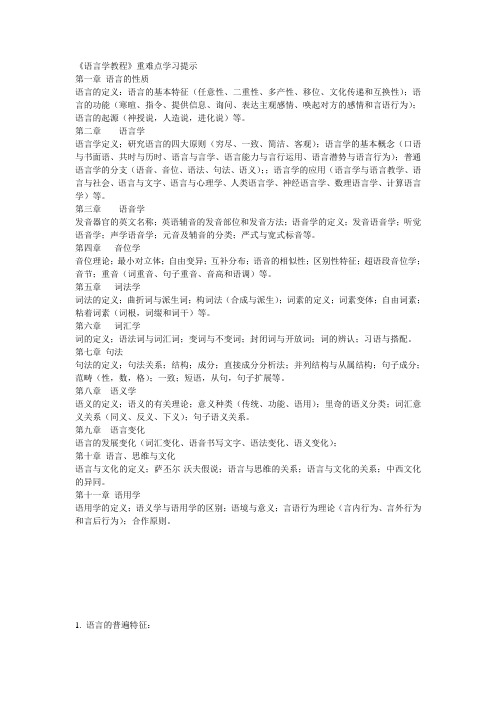
《语言学教程》重难点学习提示第一章语言的性质语言的定义:语言的基本特征(任意性、二重性、多产性、移位、文化传递和互换性);语言的功能(寒暄、指令、提供信息、询问、表达主观感情、唤起对方的感情和言语行为);语言的起源(神授说,人造说,进化说)等。
第二章语言学语言学定义;研究语言的四大原则(穷尽、一致、简洁、客观);语言学的基本概念(口语与书面语、共时与历时、语言与言学、语言能力与言行运用、语言潜势与语言行为);普通语言学的分支(语音、音位、语法、句法、语义);;语言学的应用(语言学与语言教学、语言与社会、语言与文字、语言与心理学、人类语言学、神经语言学、数理语言学、计算语言学)等。
第三章语音学发音器官的英文名称;英语辅音的发音部位和发音方法;语音学的定义;发音语音学;听觉语音学;声学语音学;元音及辅音的分类;严式与宽式标音等。
第四章音位学音位理论;最小对立体;自由变异;互补分布;语音的相似性;区别性特征;超语段音位学;音节;重音(词重音、句子重音、音高和语调)等。
第五章词法学词法的定义;曲折词与派生词;构词法(合成与派生);词素的定义;词素变体;自由词素;粘着词素(词根,词缀和词干)等。
第六章词汇学词的定义;语法词与词汇词;变词与不变词;封闭词与开放词;词的辨认;习语与搭配。
第七章句法句法的定义;句法关系;结构;成分;直接成分分析法;并列结构与从属结构;句子成分;范畴(性,数,格);一致;短语,从句,句子扩展等。
第八章语义学语义的定义;语义的有关理论;意义种类(传统、功能、语用);里奇的语义分类;词汇意义关系(同义、反义、下义);句子语义关系。
第九章语言变化语言的发展变化(词汇变化、语音书写文字、语法变化、语义变化);第十章语言、思维与文化语言与文化的定义;萨丕尔-沃夫假说;语言与思维的关系;语言与文化的关系;中西文化的异同。
第十一章语用学语用学的定义;语义学与语用学的区别;语境与意义;言语行为理论(言内行为、言外行为和言后行为);合作原则。
《语言学教程》重点笔记(2020年)

《语言学教程》重点笔记(2020年)语言学教程笔记第一章语言学导论语言的定义特征:从本质上将人类语言与动物语言区分开的人类语言的区别性特点。
1.任意性:任意性是指语言符号的形式与所表示的意义没有天然的联系,任意性是语言的核心特征。
例如,我们无法解释为什么一本书读作a /buk/,一支钢笔读作a /pen/。
任意性具有不同层次:(1)语素音义关系的任意性。
(2)句法层面上的任意性。
(3)任意性和规约性。
2.二层性:二层性是指拥有两层结构的这种特性,上层结构的单位由底层结构的元素构成,每层都有自身的组合规则。
话语的组成元素是本身不传达意义的语音,语音的唯一作用就是相互组合构成有意义的单位,比如词。
因为底层单位是无意的,而上层单位有明确的意义,所以我们把语音叫做底层单位,与词等上层单位相对。
二层性使语言拥有了一种强大的能产性。
3.创造性:创造性指语言的能产性,指语言有制造无穷长句的潜力,这来源于语言的二层性和递归性。
利用二重性说话者可以通过组合基本语言单位,无止境地生成句子,大多数都是以前没有过的或没有听过的。
4.移位性:是指人类语言可以让使用者在交际时用语言符号代表时间上和空间上并不可及的物体、时间或观点。
因此我们可以提及孔子或北极,虽然前者已经去世两千五百五十多年而后者位置距我们非常之远。
语言使我们能够谈及已不存在或还未出现的事物。
移位性赋予人们的概括与抽象能力使人类受益无穷。
词在指称具体物体时,并不总是出现在即时、形象化的语境中。
他们通常为了体现指称含义而被使用。
5.文化传递性:语言不是靠遗传,而是通过文化传递的。
6.互换性:指人可以是信息的发出者,也可以是信息的接受者,即人作为说话者和听话者的角色是可以随意更换的。
元语言功能:我们的语言可以用来讨论语言本身。
比如说,我可以用“书”指代一本书,也可以用“书这个词”来指代“书”这个词本身。
这使语言具有无限的自我反身性:人类可以谈论“说话”,也可以思考“思考”。
《语言学教程》重点笔记(2020年)
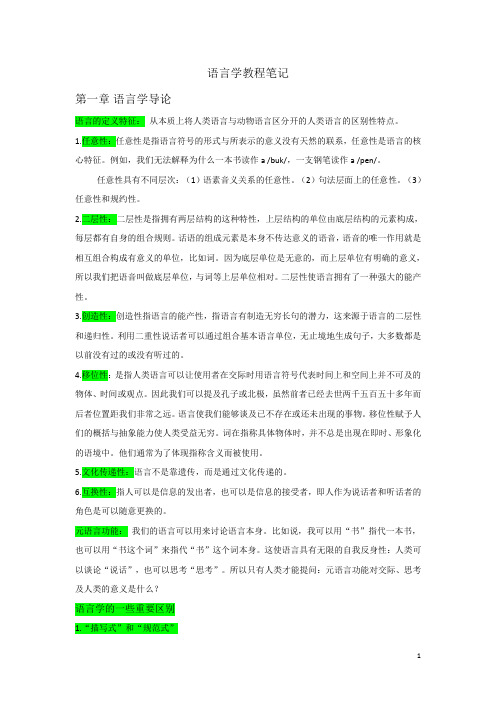
语言学教程笔记第一章语言学导论语言的定义特征:从本质上将人类语言与动物语言区分开的人类语言的区别性特点。
1.任意性:任意性是指语言符号的形式与所表示的意义没有天然的联系,任意性是语言的核心特征。
例如,我们无法解释为什么一本书读作a /buk/,一支钢笔读作a /pen/。
任意性具有不同层次:(1)语素音义关系的任意性。
(2)句法层面上的任意性。
(3)任意性和规约性。
2.二层性:二层性是指拥有两层结构的这种特性,上层结构的单位由底层结构的元素构成,每层都有自身的组合规则。
话语的组成元素是本身不传达意义的语音,语音的唯一作用就是相互组合构成有意义的单位,比如词。
因为底层单位是无意的,而上层单位有明确的意义,所以我们把语音叫做底层单位,与词等上层单位相对。
二层性使语言拥有了一种强大的能产性。
3.创造性:创造性指语言的能产性,指语言有制造无穷长句的潜力,这来源于语言的二层性和递归性。
利用二重性说话者可以通过组合基本语言单位,无止境地生成句子,大多数都是以前没有过的或没有听过的。
4.移位性:是指人类语言可以让使用者在交际时用语言符号代表时间上和空间上并不可及的物体、时间或观点。
因此我们可以提及孔子或北极,虽然前者已经去世两千五百五十多年而后者位置距我们非常之远。
语言使我们能够谈及已不存在或还未出现的事物。
移位性赋予人们的概括与抽象能力使人类受益无穷。
词在指称具体物体时,并不总是出现在即时、形象化的语境中。
他们通常为了体现指称含义而被使用。
5.文化传递性:语言不是靠遗传,而是通过文化传递的。
6.互换性:指人可以是信息的发出者,也可以是信息的接受者,即人作为说话者和听话者的角色是可以随意更换的。
元语言功能:我们的语言可以用来讨论语言本身。
比如说,我可以用“书”指代一本书,也可以用“书这个词”来指代“书”这个词本身。
这使语言具有无限的自我反身性:人类可以谈论“说话”,也可以思考“思考”。
所以只有人类才能提问:元语言功能对交际、思考及人类的意义是什么?语言学的一些重要区别1.“描写式”和“规范式”描写式:客观系统地记录一种语言的模式和用法或变化。
(完整word版)胡壮麟语言学教程笔记、重点
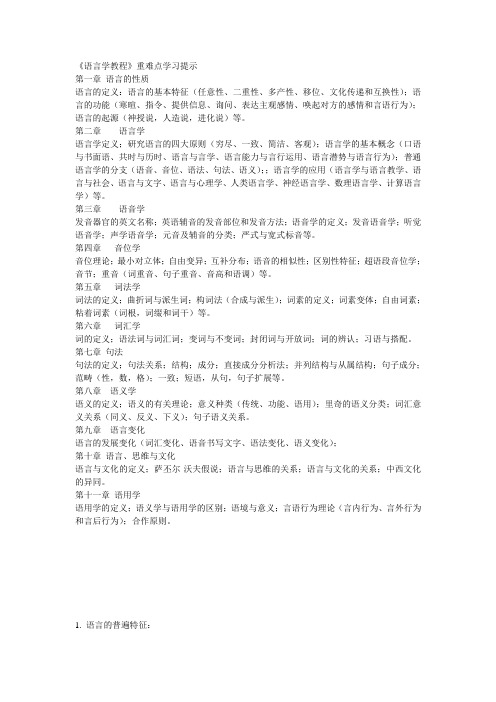
《语言学教程》重难点学习提示第一章语言的性质语言的定义:语言的基本特征(任意性、二重性、多产性、移位、文化传递和互换性);语言的功能(寒暄、指令、提供信息、询问、表达主观感情、唤起对方的感情和言语行为);语言的起源(神授说,人造说,进化说)等。
第二章语言学语言学定义;研究语言的四大原则(穷尽、一致、简洁、客观);语言学的基本概念(口语与书面语、共时与历时、语言与言学、语言能力与言行运用、语言潜势与语言行为);普通语言学的分支(语音、音位、语法、句法、语义);;语言学的应用(语言学与语言教学、语言与社会、语言与文字、语言与心理学、人类语言学、神经语言学、数理语言学、计算语言学)等。
第三章语音学发音器官的英文名称;英语辅音的发音部位和发音方法;语音学的定义;发音语音学;听觉语音学;声学语音学;元音及辅音的分类;严式与宽式标音等。
第四章音位学音位理论;最小对立体;自由变异;互补分布;语音的相似性;区别性特征;超语段音位学;音节;重音(词重音、句子重音、音高和语调)等。
第五章词法学词法的定义;曲折词与派生词;构词法(合成与派生);词素的定义;词素变体;自由词素;粘着词素(词根,词缀和词干)等。
第六章词汇学词的定义;语法词与词汇词;变词与不变词;封闭词与开放词;词的辨认;习语与搭配。
第七章句法句法的定义;句法关系;结构;成分;直接成分分析法;并列结构与从属结构;句子成分;范畴(性,数,格);一致;短语,从句,句子扩展等。
第八章语义学语义的定义;语义的有关理论;意义种类(传统、功能、语用);里奇的语义分类;词汇意义关系(同义、反义、下义);句子语义关系。
第九章语言变化语言的发展变化(词汇变化、语音书写文字、语法变化、语义变化);第十章语言、思维与文化语言与文化的定义;萨丕尔-沃夫假说;语言与思维的关系;语言与文化的关系;中西文化的异同。
第十一章语用学语用学的定义;语义学与语用学的区别;语境与意义;言语行为理论(言内行为、言外行为和言后行为);合作原则。
《语言学教程》第 3 章 形态学

扩大词汇量的工具书
语素的分类[3]
Inflectional affix [屈折词缀 ]
Derivational affix [ 派生词缀]
造新词的能力较弱,通常只 造新词的能力较强;会改 略微增加词干的语法功能; 变词的意义。 只是生成词的多种形式;通 常不明显改变词的意义。
一般不改变原词的词性 可能[不]改变原词的词性
↕
phonology
2. wording level /
morphology
言
lexicogrammatical level syntax
/词汇语法层 →
text linguistics
↕
意义 3. meaning level
semantics
层 /semantic level/语义层
→
The Phonological Hierarchy of Languages [语言的形式层之一:语音层]
增加与否取决于所属短语或 增加与否只是取决于不同
句子中的其他因素。
的表意意图。
主要是后缀。名词复数;名 前缀,后缀,或同时。
词所有格;动词第三人称单 名变动,形变副,形变动,
数;过去式;现在分词;比 形容词变否定,形变名,
较级和最高级
动变名,等
3.1.3 语素变体及形态变化
Morpheme Four
组合,具有语法意义或词汇意义。
• 7. 是一种词汇或语法单位,具有稳定性,体现为一个
或多个由若干个音位构成的组合。
关于语素定义的要点概括
• 1. 语素是最小的词汇语法单位,也是最小的意 义单位,具有词汇意义和语法意义。[兼为形 式单位和意义单位]
• 2. 语素本身具有稳定性,不可再分割,除非丧 失意义。[具有稳定性]
03_第三章_语汇

第二节 语汇的类聚系统
一,语汇系统的不同类聚关系 二,词的分类 三,语的分类
2010年6月16日
语言学概论-第三章-第二节
课间休息
结束
一,语汇系统的不同类聚关系
1,组合关系和聚合关系 , 2,语汇的不同类聚系统 ,
组合关系:符号和符号组合起来的关系. 组合关系:符号和符号组合起来的关系. 聚合关系:在语言符号组合链条中的某一环 聚合关系: 语言符号系统具有组合和类聚的特点. 组合和类聚的特点 语言符号系统具有组合和类聚的特点. 两大类. 语汇的类聚系统首先分成" 语汇的类聚系统首先分成"词"和"语"两大类. 节上能够互相替换的符号具有某种相同的作用, 节上能够互相替换的符号具有某种相同的作用, 语汇系统内部也具有组合和类聚的特点, 语汇系统内部也具有组合和类聚的特点, 既是语汇单位又是语法单位.词是最小的, 词:既是语汇单位又是语法单位.词是最小的, 并自然聚集成群,其间的关系就是聚合关系. 并自然聚集成群,其间的关系就是聚合关系. 它表现为具有相同特点的语或者词聚积成 音义结合的,能独立使用的语言单位. 音义结合的,能独立使用的语言单位. 类聚关系是在组合关系中体现出来的, 类聚关系是在组合关系中体现出来的,组合 形成一个类聚系统. 类,形成一个类聚系统. 只是语汇单位, 语:只是语汇单位,指由两个以上的词构成的意 关系又体现为聚合类的线性序列. 关系又体现为聚合类的线性序列. 义比较凝固, 义比较凝固,常作为一个整体单位使用的固定词组或 熟语性语言片断. 熟语性语言片断.
词 的 分 类
名词,动词, 名词,动词,形容词
2010年6月16日
语言学教程Chapter Three

Word class: Any class of word established by similarities in syntax or in grammar generally, known as Parts of Speech in traditional grammar. The classification first was based on classical Latin and Greek analysis, but only two classes: something like today‟s subject and predicate.
Later, nine word classes were established: Noun, pronoun, adjective, verb, adverb, preposition, conjunction, interjection, article. Today, a few more word classes have been introduced into grammar. i. Particle (小品词) – Used by C.F. Hockett in the 1950s of all forms that do not take inflection. Also by Jespersen of all the elements, e.g. in English, traditionally called adverbs, prepositions, conjunctions, and interjections. – For example, infinitive to, negative not, subordinate units in phrasal verbs “get by”, “look back”, etc. ii. Auxiliary (助动词) – A verb belonging to a small class which syntactically accompanies other verbs (opp. Lexical verb, full verb): do, have
语言学教程胡壮麟(第四版)第3章
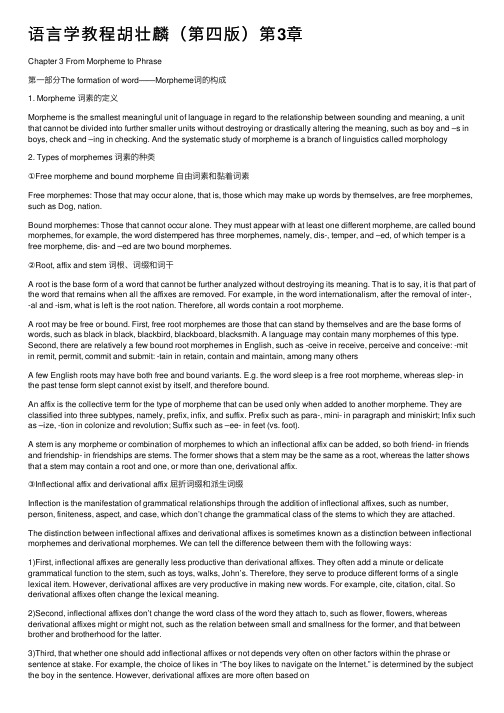
语⾔学教程胡壮麟(第四版)第3章Chapter 3 From Morpheme to Phrase第⼀部分The formation of word——Morpheme词的构成1. Morpheme 词素的定义Morpheme is the smallest meaningful unit of language in regard to the relationship between sounding and meaning, a unit that cannot be divided into further smaller units without destroying or drastically altering the meaning, such as boy and –s in boys, check and –ing in checking. And the systematic study of morpheme is a branch of linguistics called morphology2. Types of morphemes 词素的种类①Free morpheme and bound morpheme ⾃由词素和黏着词素Free morphemes: Those that may occur alone, that is, those which may make up words by themselves, are free morphemes, such as Dog, nation.Bound morphemes: Those that cannot occur alone. They must appear with at least one different morpheme, are called bound morphemes, for example, the word distempered has three morphemes, namely, dis-, temper, and –ed, of which temper is a free morpheme, dis- and –ed are two bound morphemes.②Root, affix and stem 词根、词缀和词⼲A root is the base form of a word that cannot be further analyzed without destroying its meaning. That is to say, it is that part of the word that remains when all the affixes are removed. For example, in the word internationalism, after the removal of inter-, -al and -ism, what is left is the root nation. Therefore, all words contain a root morpheme.A root may be free or bound. First, free root morphemes are those that can stand by themselves and are the base forms of words, such as black in black, blackbird, blackboard, blacksmith. A language may contain many morphemes of this type. Second, there are relatively a few bound root morphemes in English, such as -ceive in receive, perceive and conceive: -mit in remit, permit, commit and submit: -tain in retain, contain and maintain, among many othersA few English roots may have both free and bound variants. E.g. the word sleep is a free root morpheme, whereas slep- in the past tense form slept cannot exist by itself, and therefore bound.An affix is the collective term for the type of morpheme that can be used only when added to another morpheme. They are classified into three subtypes, namely, prefix, infix, and suffix. Prefix such as para-, mini- in paragraph and miniskirt; Infix such as –ize, -tion in colonize and revolution; Suffix such as –ee- in feet (vs. foot).A stem is any morpheme or combination of morphemes to which an inflectional affix can be added, so both friend- in friends and friendship- in friendships are stems. The former shows that a stem may be the same as a root, whereas the latter shows that a stem may contain a root and one, or more than one, derivational affix.③Inflectional affix and derivational affix 屈折词缀和派⽣词缀Inflection is the manifestation of grammatical relationships through the addition of inflectional affixes, such as number, person, finiteness, aspect, and case, which don’t change the grammatical class of the stems to which they are attached.The distinction between inflectional affixes and derivational affixes is sometimes known as a distinction between inflectional morphemes and derivational morphemes. We can tell the difference between them with the following ways:1)First, inflectional affixes are generally less productive than derivational affixes. They often add a minute or delicate grammatical function to the stem, such as toys, walks, John’s. Therefore, they serve to produce different forms of a single lexical item. However, derivational affixes are very productive in making new words. For example, cite, citation, cital. So derivational affixes often change the lexical meaning.2)Second, inflectional affixes don’t change the word class of the word they attach to, such as flower, flowers, whereas derivational affixes might or might not, such as the relation between small and smallness for the former, and that between brother and brotherhood for the latter.3)Third, that whether one should add inflectional affixes or not depends very often on other factors within the phrase or sentence at stake. For example, the choice of likes in “The boy likes to navigate on the Internet.” is determined by the subject the boy in the sentence. However, derivational affixes are more often based onsimple meaning distinctions. For example, the choice of clever and cleverness depends on whether we want to talk about the property “clever” or we want to talk about “the state of being clever”.4)Fourth, in English, most inflectional affixes are suffixes, which are always word final. E.g. drums, walks, Mary’s. But derivational affixes can be either prefixes, suffixes, or both at the same time. E.g. depart, teacher, international.3. Allomorph and morphological change 变体①allomorph 词素变体An allomorph is the alternate shapes of the same morpheme. Words such as illogical, imbalance, irregular and inactive share a common morpheme in-. In other words, il-, im-, and ir- are exceptionally the variation forms of one morpheme in-. These variation forms are called Allomorphs, i.e. allomorphs of the same morpheme owing to the influence of the sounds to which it attaches.②morphological change 形态变化Morphological change takes the form of inflectional changes in affixes.第⼆部分Word 词1. word 词和词项的定义Word is a typical grammatical unit between Morpheme and Word Group, such as boy, check, write, and fat. Lexical items refer to the cases when a word appears in different forms, such as boy and boys, or check, checks, checked, and checking. So Word is a general, covering term (boy and boys are one word) and Lexical Item a specific term (boy and boys are two lexical items).2. Three characteristics of word 词的三个特性①Stability 稳定性Words, concerning their internal structures, are the most stable of all linguistic units, Generally speaking, it is hard for one to re-arrange the internal structure of a complex word into a different order. For example, the word chairman cannot be re-arranged as * manchair, the latter being an unacceptable word in English.②Relative uninterruptibility 相对连续性Uninterruptibility means that new elements should not be inserted into a word, even when there are several parts in it. For example, nothing should be inserted in between the three parts of the word disappointment: dis + appoint + ment.③ A minimum free form 最⼩的⾃由形式Leonard Bloomfield advocated treating sentence as “the maximum free form” while word as “the minimum free form”. Word is the smallest unit that can be used, by itself, as a complete utterance. For example, Is Jane coming tomorrow? Possibly.3. Classification of words 词的种类①Variable and invariable words 可变词与不变词V ariable words have inflective changes. That is, the same word may have different grammatical forms but part of the word remains relatively constant. E.g. follow – follows – following – followed.Invariable words refer to those such as since, when, seldom, hello. They don’t have inflective endings.②Grammatical words and lexical words 语法词(功能词)和词汇词(实义词)Grammatical words(function words):Those that mainly work for constructing group, phrase, clause, clause complex, or even text are grammatical words, such as conjunctions, prepositions, articles and pronouns. Lexical words(content words):Those that mainly work for referring to substance, action and quality, such as nouns, verbs, adjectives and adverbs, are lexical words.③Closed-class words and open-class words 封闭类词和开放类词Closed-class word: A word that belongs to the Closed-class is one whose membership is fixed or limited, such as pronouns, prepositions, conjunctions, articles, and others.Open-class word: the Open-class is one whose membership is in principle infinite or unlimited. When new ideas, inventionsor discoveries emerge, new members are continually and constantly added to the lexical system of a language.④Word class(part of speech)词类This is close to the notion of parts of speech in traditional grammar.Nine word classes were established: they were noun, verb, adjective, adverb, conjunction, preposition, article, pronoun, and interjection.Today, a few more word classes have been introduced into grammer.i. Particles助词Particles include at least the infinitive marker “to” , the negative marker “not”, and the subordinate units in phrasal verbs, such as “get by”, “do up”, “look back”.ii. Auxiliaries助动词Auxiliaries used to be regarded as verbs. Because of their unique properties, which one could hardly expect of a verb, linguists today tend to define them as a separate word class.iii. Pro-form代词形式The items in a sentence which substitute for other items or constructions are called Pro-forms. For example, in the following conversation, so replaces that I can come.A: I hope you can come.B: I hope so.iv. Determiners限定词Determiners refer to those words that are used before the noun acting as head of a noun group, and that determine the kind of reference the nominal group has.第三部分Word formation 词汇构成1. Word formation(1):From Morpheme to Word 从词素到词(1) The inflectional way of formationInflection indicates grammatical relations by adding inflectional affixes, such as number, person, finiteness, aspect and case, which don’t change the grammatical class of the stems to which they are attached. For example, Table/tables.(2) The derivational way of formationDerivation, in its restricted sense, refers to the process of how new words are formed. It can be further divided into two sub-types: the derivational type (derivation) and the compositional type (compound).①Derivation派⽣Derivation shows a relationship between roots and affixes. In contrast to inflections, derivations can make the word class of the original word either changed or unchanged.E.g. Changed: delight+ful=delightful; unchanged: non+smoker= nonsmoker②Compound合成Compounds refer to those words that consist of more than one lexical morpheme, or the way to join two separate words to produce a single form, such as sunrise, cloakroom, railway. It can be divided into two types:(1) Invention 发明法Technological and economic activities are the most important and dynamic in modern human life, many new lexical items come directly from them, such as Coke, nylon.(2) Blending 混成法Blending is a relatively complex form of compounding, in which two words are blended by joining together the initial part of the first word and the final part of the second word, or by only joining the initial parts of the two words. For example, smoke+ fog →smog; breakfast + lunch →brunch.(3) Abbreviation / Clipping 缩写法/截断法A new word is created by cutting the initial part or the final part or cutting both the initial and the final parts of the original words. E. g. telephone→phone; fanatic→fan; influenza→flu.(4) Acronym ⾸字母缩略词Acronym is made up from the first letters of the name of an organization, which has a heavily modified headword. E. g. WTO→World Trade Organization(5) Back-formation 逆构词法Back-formation refers to an abnormal type of word-formation where a shorter word is derived by deleting an imagined affix from a longer form already in the language. E. g. editor→edit(6) Analogical creation 类推构词法The principle of analogical creation can account for the co-existence of two forms, regular and irregular, in the combination of some English verbs. E. g. work →wrought →worked.(7) Class shift 词性变换By shifting word class one can change the meaning of a word from a concrete entity or notion to a process or attribution. This process of word formation is also known as zero-derivation, or conversion. E. g. Engineer(v/n)(8) Borrowing 借⽤English in its development has managed to widen its vocabulary by borrowing words from other languages, such as Greek, French, Spanish and other languages have all played an active role in this process. There are four types of borrowing:①Loanwords(全部借词):a process in which both form and meaning are borrowed with only a slight change.E. g. coup d’ état , tea , 秀,脱⼝秀②Loanblend(混合借词):a process in which part of the form is native and the rest has been borrowed, but the meaning is fully borrowed. E. g. Chinatown 吉普车③Loanshift(转移借词):a process in which the meaning is borrowed, but the form is native. E. g. artificial satellite from the Russian S putnik.④Loan translation(翻译借词):a special type of borrowing, in which each morpheme or word is translated in the equivalent morpheme or word in another language, also called Calque. E. g. black humor (humour noir), found object (objet trouve).第四部分Word group and phrase 词组和短语Word group is a group of words, it is an expansion of a word.Phrase is a contraction of a clause nominal group, such as Verbal group, Adverbial group, preposition group.。
(完整版)胡壮麟语言学教程笔记、重点全解

《语言学教程》重难点学习提示第一章语言的性质语言的定义:语言的基本特征(任意性、二重性、多产性、移位、文化传递和互换性);语言的功能(寒暄、指令、提供信息、询问、表达主观感情、唤起对方的感情和言语行为);语言的起源(神授说,人造说,进化说)等。
第二章语言学语言学定义;研究语言的四大原则(穷尽、一致、简洁、客观);语言学的基本概念(口语与书面语、共时与历时、语言与言学、语言能力与言行运用、语言潜势与语言行为);普通语言学的分支(语音、音位、语法、句法、语义);;语言学的应用(语言学与语言教学、语言与社会、语言与文字、语言与心理学、人类语言学、神经语言学、数理语言学、计算语言学)等。
第三章语音学发音器官的英文名称;英语辅音的发音部位和发音方法;语音学的定义;发音语音学;听觉语音学;声学语音学;元音及辅音的分类;严式与宽式标音等。
第四章音位学音位理论;最小对立体;自由变异;互补分布;语音的相似性;区别性特征;超语段音位学;音节;重音(词重音、句子重音、音高和语调)等。
第五章词法学词法的定义;曲折词与派生词;构词法(合成与派生);词素的定义;词素变体;自由词素;粘着词素(词根,词缀和词干)等。
第六章词汇学词的定义;语法词与词汇词;变词与不变词;封闭词与开放词;词的辨认;习语与搭配。
第七章句法句法的定义;句法关系;结构;成分;直接成分分析法;并列结构与从属结构;句子成分;范畴(性,数,格);一致;短语,从句,句子扩展等。
第八章语义学语义的定义;语义的有关理论;意义种类(传统、功能、语用);里奇的语义分类;词汇意义关系(同义、反义、下义);句子语义关系。
第九章语言变化语言的发展变化(词汇变化、语音书写文字、语法变化、语义变化);第十章语言、思维与文化语言与文化的定义;萨丕尔-沃夫假说;语言与思维的关系;语言与文化的关系;中西文化的异同。
第十一章语用学语用学的定义;语义学与语用学的区别;语境与意义;言语行为理论(言内行为、言外行为和言后行为);合作原则。
